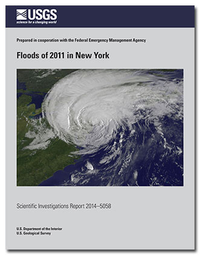Floods of 2011 in New York
Links
- More information: USGS Index Page
- Document: Report
- Plates:
- Download citation as: RIS | Dublin Core
Abstract
Record rainfall combined with above-average temperatures and substantial spring snowmelt resulted in record flooding throughout New York during 2011. Rainfall totals in eastern New York were the greatest since 1895 and as much as 60 percent above the long-term average within the Catskill Mountains area and the Susquehanna River Basin. This report documents the three largest storms and resultant flooding during the year: (1) spring storm during April and May, (2) Tropical Storm Irene during August, and (3) remnants of Tropical Storm Lee during September. According to the Federal Emergency Management Agency (FEMA), the cost of these three storms exceeded $1 billion in Federal disaster assistance.
A warm and wet spring in northern New York resulted in record flooding at 21 U.S. Geological Survey (USGS) active streamgages during late April to early May with the annual exceedance probabilities (AEPs) of 11 peak discharges equaling or exceeding 1 percent. Nearly 5 inches of rain during late April combined with a rapidly melting snowpack caused widespread flooding throughout northern New York, resulting in many road closures, millions of dollars in damages, and 23 counties declared disaster areas and eligible for public assistance. On May 6, Lake Champlain recorded its highest lake level in over 140 years.
Hurricane Irene entered New York State on August 28 as a tropical storm and traveled up the eastern corridor of the State, leaving a path of destruction and damage never seen in many parts of New York. Thirty-one counties in New York were declared disaster areas with damages of over $1.3 billion dollars and 10 reported deaths. Storm rainfall exceeded 18 inches in the Catskill Mountains area of southeastern New York with many other areas of eastern New York receiving over 7 inches. Catastrophic flooding resulted from the extreme rainfall in many locations, including Schoharie Creek and its tributaries, the eastern Delaware River Basin, the Ausable and Bouquet River Basins in northeastern New York, and several other stream basins throughout southeastern New York. Downstream reaches of the Mohawk River also had substantial flooding. Sixty-two USGS streamgages throughout eastern New York documented record high stream flows and elevations with AEPs of 25 peak discharges equaling or exceeding 1 percent. The USGS streamgage for the Schoharie Creek at Prattsville recorded its greatest peak discharge in 109 years of record at 120,000 cubic feet per second (greater than the 0.2-percent AEP discharge) on August 28. The peak water-surface elevation at the streamgage in Prattsville was 5 feet higher than its previous record in 1996. USGS personnel surveyed 184 high-water marks (HWMs) at 30 locations along an 84-mile reach of Schoharie Creek and compared the elevations to those published by FEMA for the 10-, 2-, 1-, and 0.2-percent AEP floods. Elevations in the lower reaches of the basin exceeded published elevations for the 0.2-percent AEP flood.
Remnants of Tropical Storm Lee brought a third major storm to New York in September 2011. Moisture from Lee began moving into New York on September 7 and intensified over the already saturated Susquehanna River Basin. Most of the rain fell on September 8 with storm totals nearing 13 inches in some areas (12.73 inches at Apalachin in Tioga County). Major disaster declarations were issued for 15 counties in and around central New York, making them eligible for individual or public assistance. Ten USGS streamgages within the Susquehanna River Basin documented record-high stream discharges and elevations on September 8, and all were greater than the 1-percent AEP discharge. USGS personnel surveyed 20 HWMs at 18 locations along a 114- mile reach of the Susquehanna River and compared the elevations to those published by FEMA for the 10-, 2-, 1-, and 0.2-percent AEP floods. Several of the surveyed HWMs exceeded published elevations for the 0.2-percent AEP flood.
Study Area
| Publication type | Report |
|---|---|
| Publication Subtype | USGS Numbered Series |
| Title | Floods of 2011 in New York |
| Series title | Scientific Investigations Report |
| Series number | 2014-5058 |
| DOI | 10.3133/sir20145058 |
| Year Published | 2014 |
| Language | English |
| Publisher | U.S. Geological Survey |
| Publisher location | Reston, VA |
| Contributing office(s) | New York Water Science Center |
| Description | Report: xii, 235 p.; 5 Plates: 36.0 x 30.0 inches |
| Time Range Start | 2011-01-01 |
| Time Range End | 2011-12-31 |
| Country | United States |
| State | New York |
| Online Only (Y/N) | N |
| Additional Online Files (Y/N) | Y |


